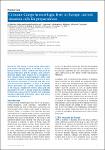Crimean-Congo hemorrhagic fever in Europe: current situation calls for preparedness
Maltezou, H. C.
Andonova, L.
Andraghetti, R.
Bouloy, M.
Ergonul, O.
Jongejan, F.
Kalvatchev, N.
Nichol, S.
Niedrig, Matthias
Platonov, A.
Thomson, Gail
Leitmeyer, Katrin
Zeller, Hervé
During the last decade Crimean-Congo hemorrhagic fever (CCHF) emerged and/or re-emerged in several Balkan countries, Turkey, southwestern regions of the Russian Federation, and the Ukraine, with considerable high fatality rates. Reasons for re-emergence of CCHF include climate and anthropogenic factors such as changes in land use, agricultural practices or hunting activities, movement of livestock that may influence host-tick-virus dynamics. In order to be able to design prevention and control measures targeted at the disease, mapping of endemic areas and risk assessment for CCHF in Europe should be completed. Furthermore, areas at risk for further CCHF expansion should be identified and human, vector and animal surveillance be strengthened.
Dateien zu dieser Publikation
Keine Lizenzangabe
Verwandte Publikationen
Anzeige der Publikationen mit ähnlichem Titel, Autor, Urheber und Thema.
-
2014-07-03ZeitschriftenartikelEuropean survey on laboratory preparedness, response and diagnostic capacity for Crimean-Congo haemorrhagic fever, 2012 Fernandez-García, M. D.; Negredo, A.; Papa, Anna; Mantke, Oliver Donoso; Niedrig, Matthias; Zeller, Hervé; Tenorio, Antonio; Franco, LeticiaCrimean-Congo haemorrhagic fever (CCHF) is an infectious viral disease that has (re-)emerged in the last decade in south-eastern Europe, and there is a risk for further geographical expansion to western Europe. Here we ...
-
2016-03-01ZeitschriftenartikelAssessment of Recombination in the S-segment Genome of Crimean-Congo Hemorrhagic Fever Virus in Iran Chinikar, Sadegh; Shah-Hosseini, Nariman; Bouzari, Saeid; Shokrgozar, Mohammad Ali; Mostafavi, Ehsan; Jalali, Tahmineh; Khakifirouz, Sahar; Groschup, Martin H.; Niedrig, MatthiasBackground: Crimean-Congo Hemorrhagic Fever Virus (CCHFV) belongs to genus Nairovirus and family Bunyaviridae. The main aim of this study was to investigate the extent of recombination in S-segment genome of CCHFV in Iran. ...
-
2017-07-14ZeitschriftenartikelGeneric amplification and next generation sequencing reveal Crimean-Congo hemorrhagic fever virus AP92-like strain and distinct tick phleboviruses in Anatolia, Turkey Dinçer, Ender; Brinkmann, Annika; Hekimoğlu, Olcay; Hacıoğlu, Sabri; Földes, Katalin; Karapınar, Zeynep; Polat, Pelin Fatoş; Oğuz, Bekir; Kılınç, Özlem Orunç; Hagedorn, Peter; Özer, Nurdan; Özkul, Aykut; Nitsche, Andreas; Ergünay, KorayBackground: Ticks are involved with the transmission of several viruses with significant health impact. As incidences of tick-borne viral infections are rising, several novel and divergent tick- associated viruses have ...

